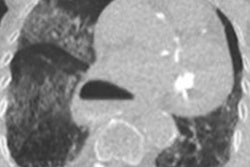
The volume of CT studies performed in the U.S. has recovered since the early days of the COVID-19 pandemic. But as of the end of September, it was still far below prepandemic expectations, according to registry study data published in the Journal of the American College of Radiology.
CT volume suffered the worst blows 32 days after emergency declarations and stay-at-home orders in states in early 2020, with a 53% reduction in exam volume, according to an analysis of data from January through the end of September from the American College of Radiology (ACR) Dose Index Registry.
At the end of September, daily CT volume had rebounded to about 84% of what would have been expected based on studies conducted during the prepandemic period. Over the entire study period, exam volume was 19% lower than expectations, reported Dr. Matthew Davenport, clinical associate professor of radiology and urology at the University of Michigan and colleagues.
"COVID-19 substantially reduced United States CT volume, reflecting delayed and deferred care, especially in states with greater unemployment," Davenport et al wrote.
The ACR's CT Dose Registry is normally used to track radiation dose safety, but it has found a new purpose during the pandemic for tracking CT volume as the coronavirus waxes and wanes. From the start of January to the end of September, 18,947,969 CT scans would have been expected to be performed, but the actual rate was 19% lower than that. As states opened up, volume has increased, but it is still lower than expected.
The ACR Dose Index Registry is providing a "powerful real-time method of studying imaging volumes in the United States, and it can serve as a real-time indicator of health care access," Davenport et al wrote.
The new study included CT exams conducted at 2,398 radiology practices, including academic groups, community hospitals, multispecialty clinics, and freestanding imaging centers across the country. Researchers compared current volume against what would be expected based on practice for the years prior to the pandemic.
A lower decline in CT volume was reported in states that had smaller populations, Davenport et al wrote. Healthcare systems have responded to the pandemic by restricting access to healthcare service, including computed tomography scans, they noted.
From January to the end of September, some 3.7 million fewer CT examinations were conducted than would have normally been performed, according to the study. If the risk from COVID-19 is greater than the risk from a delay in care, the care should be delayed, but the opposite is also true and necessary care should proceed in a timely fashion, the authors concluded.




















